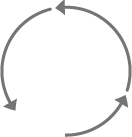I read the term « Cross-pollinator » for the first time in a great book written by californian-design-firm-IDEO-founder Tom Kelley : The ten faces of innovation – Strategies for heightening creativity (2006).
This book is about « how people and teams put into practice methods and techniques that infuse an enterprise with a continuous spirit of creative evolution ». Among the 10 types of people a company needs to strengthen its creativity is the cross-polinator.
Cross-pollinators are an « essential part of the ecosystem of innovation ». They are good students but good teachers as well and have a childlike ability to see patterns others don’t see and they can apply them in new contexts.
What makes a cross-polinator?
Cross-pollinators can create something new and better through the unexpected juxtaposition of seemingly unrelated ideas or concepts. They often innovate by discovering a clever solution in one context or industry then translating it successfully to another.
Cross-pollinators stir-up new ideas by exploring worlds that may at first glance seem to have little relevance to the problem at hand. Actually, this is one of the key-points experimented by participants during « Learning Expeditions ».
How to recognise Cross-pollinators in your company?
- They often think in metaphors, enabling them to see relationships and connections that others miss. They act as matchmakers, creating unusual combinations, approachs, that often spark innovative hybrids.
- They are Multifaceted, known as « T-shaped » individuals : they enjoy a breadth of knowledge [empathy accross disciplines] in many fields, but they also have depth [deep knowledge] in at least one area of expertise. They defy simple categorization, but don’t let that bother your.
- They don’t fear scarcity. « Necessity is the mother of invention » : scarcity and tough constraints force you to be innovative. They know how to challenge a team to come up with something on the cheap.
- They are confident that diverse and interesting projects work can fuel the fire of a culture of innovation. Like linguists : the more languages they master, the easier it becomes to absorb the next one.
- They are open-minded : they are receptive and know that success can come from the most unlikely of all directions.
- They are Boomerang staffers »: Independent, they might work for a company for a while, go out and get broad experience elsewhere, ant then come back. Give them a chance to find some fertile soil and you won’t regret it!
- They tirelessly spreads the seeds of innovation : they have wide interests, voracious curiosity, and an aptitude for learning and teaching.
For your company, it is hence essential to learn how to flower cross-pollination!
To know more about The 10 Faces of Innovation by Tom Kelley










